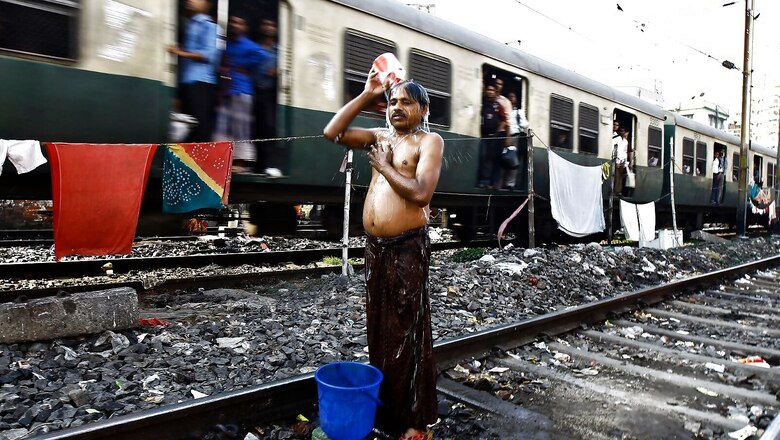
views
The Indian Railways claims to have 29 acres of land under encroachment in Uttarakhand’s Haldwani, where close to 50,000 people were directed to be “removed” by the high court. The eviction order, stayed by the Supreme Court on Thursday, gave relief to over 4,000 families, a majority of them Muslims, that reside on disputed land. The families, however, assert that they are the rightful owners of the land as they have been residing on it for over 50 years.
This is not the first such encroachment case related to railway land. Here are some other cases from recent times, which show how illegal occupation is a multipronged issue in India where the sight of slums, or jhuggis’, along railway tracks is common:
The Surat-Udhna to Jalgaon Railway Line project in Gujarat remains incomplete due to unauthorised structures on railway property for at least 2.65 km, said the Supreme Court in December 2021, while hearing pleas raised against issues related to removal of encroachment from railway land in Gujarat and Haryana. The top court was also hearing a plea related to demolition of ‘jhuggis’ on railway tracks in Faridabad. In the Gujarat matter, 5,000 ‘jhuggis’ have to be demolished in order for the railway line project to come up.
For the Mumbai-Ahmedabad bullet train project, state and railway authorities had first attempted to evict the residents of the slum dwellings at JP Ni Chali in Sabarmati area in 2018. The residents have claimed that they have been living in the area since 1991 with migrants from different districts coming in, and that the population had grown to at least 70 slum dwellings with a population of 350 by 2021. In October 2021, the authorities said 75 evicted slum dwellers were not entitled to rehabilitation. They told the Gujarat HC that the evicted people cannot be considered as “project-affected” and are not entitled to benefits under the resettlement and rehabilitation policy. The hearing was based on a PIL filed by Ahmedabad-based trade union Bandhkaam Mazdoor Sangathan. The National High Speed Railway Corporation Ltd had come for a survey in the area in 2018 and had verbally assured slum residents that they will not be asked to vacate their land without rehabilitation. The authorities had promised houses under the Pradhan Mantri Awas Yojana or the state policy for affordable housing. But residents got a notice to vacate the site in February 2022 and, on March 15, the railway administration started demolishing the settlements. The anti-encroachment drive left 318 people homeless.
In August 2020, there was another tussle in the courts about compensation issues on vacating railway land. In this, the Bombay High Court said the railways cannot acquire land without arranging for compensation and rehabilitation. According to report published in Hindustan Times, the court was hearing a petition filed by Premier Ltd seeking a direction to Dedicated Freight Corridor Corporation of India Limited (DFCCIL), a subsidiary of the Indian Railways, to release compensation amount of Rs 21.71 crore for 28,672 sq m of the company’s land at Bhopar in Thane district. The piece of land was acquired by DFCCIL for the Western Dedicated Freight Corridor, which is a special railway project over 1483 km from Jawaharlal Nehru Port Trust to Dadri in Haryana.
In the winter of 2015, a toddler was killed in a case of alleged negligence during a demolition drive by the Indian Railways at Delhi’s Shakur Basti. A case of death due to negligence was registered. Back then, chief minister Arvind Kejriwal had said no such demolition will be allowed without rehabilitation. Even the Delhi High Court came down heavily on the ministry of railways and police for razing the slum cluster and directed the authorities to rehabilitate over 5,000 people rendered homeless in the biting cold. According to news agency PTI, the post-mortem report of the six-month-old girl showed that she died due to shock and injuries on the chest and head due to the impact of blunt force. The report also mentioned fractures in the ribs and head. The railways, however, denied the charges and said the baby died two hours before the demolition drive began. Over 1,200 slum units were removed in this drive.
In February 2022, it was reported that over 20,000 illegal structures on railway land delayed expansion projects in Mumbai. There are a total of 24,500 unauthorised structures on railway land in the Mumbai division, covering 57 hectares of land and in areas where future expansion projects are planned. According to a report published in Times of India, there are around 13,839 such structures occupying 37.29 hectares of land on the Central Railway, with most in Kurla, Mankhurd and Kurla-Trombay line. On the Western Railway, the number of illegal structures are 10,572 and most were found in Bandra-Khar belt.
In July 2022, a reply to an RTI revealed that temples covered over 57 percent encroached land with the Agra division. Mosques and tombs illegally occupied 2.8 percent, according to a report published by Times of India. The remaining area has residential spaces and other structures. The report stated that a total of 21,875 sq m of land was encroached upon, out of which over 13,233 sq m was under illegal occupation by places of worship or religious sites. The Agra railway division, which is part of the North Central Railway covers 829.35 km spreading across nine districts in Rajasthan and Haryana. “Not just Agra division, a majority of encroachment across north central railway are religious sites. Illegal constructions on railway property – for example, a temple on the platform at Raja-ki-Mandi railway station in Agra city – violate safety norms and significantly affect standard operations. With hardly any help from the state government and the local administration, railway authorities also avoid taking legal action against illegally developed religious sites,” an official was quoted as saying in the report.
In September 2022, encroachment at Dimapur railway station became a major issue. Under the Northeast Frontier Railway, the railway station at Nagaland’s largest city has ranked below other smaller and newer stations. Illegal occupation also includes religious structures, and due to this a planned double track from Dhansiri is skirting Dimapur and being diverted through Dillai to Bokajan, according to media reports. There have been concerns that no development can take place if the land is not made available.
In a bizarre turn of events, the Indian Railways sent a notice to Hindu deity Hanuman ordering him to vacate temple premises dedicated to him in Jharkhand’s Dhanbad, last year in October. The notice is directly addressed to the deity and states that the temple near Khatik Basti is an encroachment. The same notice has also been sent to some others, who claimed that they had been living in this area since 1921. Calling it “illegal occupation”, the railways has pasted a notice ordering people to vacate all houses of the locality.
In November 2022, the Kerala government recalled officials involved in conducting a social impact assessment study for the SilverLine rail corridor project. According to a report published in The Indian Express, the state government started acquiring land for the project in June 2021. Out of 1,383 hectares of land needed to be acquired, 1,198 hectares will be private. The state witnessed large-scale and violent protests early that year, fuelled by the opposition Congress and BJP. There were concerns that the project was not financially viable and would lead to the displacement of over 30,000 families. Hence, in March, railway minister Ashwini Vaishnaw in Lok Sabha expressed that the environmental concerns around the project were “real” as activists said the routes of the Silverline cut through wetlands, paddy fields and hills.
In December 2022, during an anti-encroachment drive in Roorkee, railway authorities placed pillars outside now-hospitalised cricketer Rishabh Pant’s house to demarcate railway land outside Dhandera railway station. They conducted a similar exercise outside other houses, claiming that local residents in the area were encroaching upon the land by using it as a parking spot for vehicles and as a passage. The authorities said people were also dumping garbage and cow dung on this land.
(With agency inputs)
Read all the Latest India News here



















Comments
0 comment